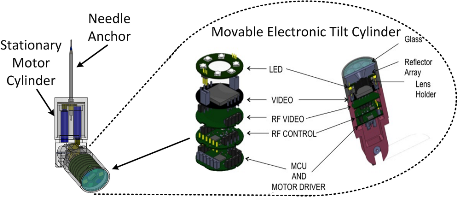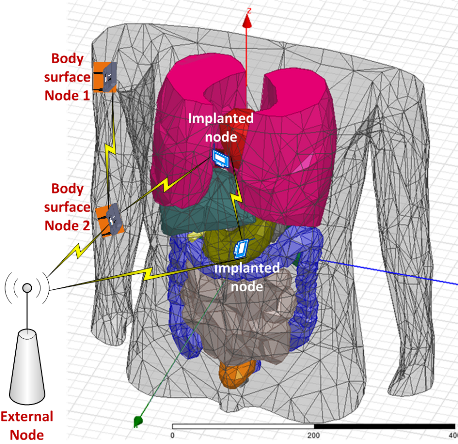The In vivo Wireless Information Networking group focuses on studying novel in vivo channel models and signal processing that will facilitate the creation of new communications protocols accommodating the limitations of implanted devices, which are more restricted, from a communication and computing standpoint, than any devices that have ever been networked by human-created means. This knowledge will be useful to improve the design and implementation of the wirelessly controlled and communicating Miniature Anchored Robotic Videoscope (MARVEL) video system (i.e., a camera) and other embedded devices that are expected to create a paradigm shift in minimally invasive surgery. Another area of research is high throughput and robust wireless body area networks (WBANs) that enable information from in vivo devices such the MARVEL camera to be reliably transmitted to external devices through packet-based nodes/gateways that are located on the human body.
Research Projects
To realize our vision, our focus is on (1) architecting, realizing, and networking a family of wirelessly controlled and communicating in vivo devices that will facilitate a new paradigm for Minimally Invasive Surgery (MIS) and (2) creating novel in vivo wireless communications and networking technology to support these devices and advance the performance of such wireless body area networks (WBANs) that will support MIS and other biomedical applications.
For a short presentation about our areas of research, research challenges and objectives, please click here
Wirelessly Controlled and Communicating
In Vivo Networked Devices: The first such device that we have implemented is a Miniature Anchored Robotic Videoscope (MARVEL), which is a wirelessly controlled and communicating high-definition video system that will provide the spatial and visual advantages of open-cavity surgeries. To achieve the above objectives several research challenges arise such as (1) reliable, high-throughput and low-latency intra-body wireless communications and networking; (2) electronic and mechanical miniaturization of complex systems; (3) autofocus algorithms for distance compensation; and (4) localization and mapping of the intra-body camera unit and surrounding organs and tissues.

Here is a demonstration (video) of some of the MARVEL CM's features
Wireless Body Area Networks (WBANs)
To network devices such as MARVEL, we are investigating high throughput, energy efficient, and robust wireless body area networks (WBANs) that enable high-speed information (e.g., real-time high-definition video) to be reliably transmitted between internal and/or to external devices. WBAN research challenges include (1) the creation of a comprehensive human-body channel model for in vivo wireless signal propagation and (2) using these models to optimize high data rate WBAN communications by inventing signal processing and communication protocols that ensure reliable and efficient communications. This approach is necessitated by limited complexity sensors and includes research on asymmetric multiple-input multiple-output (dubbed, MIMO in vivo) smart antennas, asymmetric network protocols, and emerging networking techniques, such as Diversity Coding and Network Coding. The development of these novel channel models are achieved with the aid of high frequency electromagnetic fields simulators such as ANSYS HFSS13, which also provides a complete human body model with over 300 body objects (organ, tissues, fluids, etc.) and accuracy down to 1mm that include frequency dependent electrical properties from DC to 20 GHz.

